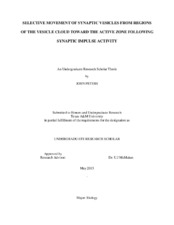| dc.description.abstract | Clouds of synaptic vesicles, which contain neurotransmitter molecules, are distributed along the length of a neuron's axon terminal. A small number of synaptic vesicles are docked on (held at) specialized regions of the presynaptic plasma membrane known as active zones. When a nerve impulse arrives at the axon terminal, the membrane of a docked synaptic vesicle fuses with the presynaptic membrane and releases its neurotransmitter molecules into the synaptic cleft where receptors on the postsynaptic cell mediate impulse transmission. The fused vesicle membrane then moves laterally and recycles into a fully functional synaptic vesicle to be used in synaptic transmission again, while a vesicle from the cloud moves to occupy the vacant docking site. I used electron tomography, which provides nanometer spatial resolution in 3 dimensions, on tissue sections from simply arranged axon terminals at frog neuromuscular junctions fixed and stained in vitro at rest and after synaptic activity at 10 pulses per second (10 Hz) for 2 minutes. The aim of my study was to determine the spatial distribution of undocked vesicles in the synaptic vesicle cloud with a view to understanding how vesicles move from the cloud to the active zone during synaptic transmission. I measured the synaptic vesicle number density and nearest neighbor distances in 3 regions of the cloud based on distance from the midline of the active zone; these regions are the proximal region (0-150 nm and includes active zone material), intermediate region (150-390 nm), and distal region (390-630 nm). I found that in the proximal region the number of synaptic vesicles per unit volume (vesicle number density) and the nearest neighbor distances were the same for both the resting and active terminals. Likewise, in the distal region, both parameters were the same in resting and active terminals. However, in the intermediate region there was a significant decline in the vesicle number density after synaptic activity. Despite the reduction in vesicle density, the nearest neighbor distances remained the same. Furthermore, I found vesicles with larger diameters than those typically found at rest distributed throughout the cloud, but they were in greatest abundance in the intermediate region. Such vesicles are likely to be newly recycled vesicles. I conclude that when synapses are active in vivo, vesicles in the region of the cloud just proximal to the active zone selectively move to occupy the docking sites on the presynaptic membrane vacated by former docked vesicles that have fused with the membrane. They, in turn, are replaced by vesicles that move in small groups from an intermediate region in the cloud, and these intermediate region vesicles are replaced more slowly by newly recycled vesicles. | en |


